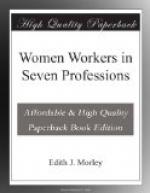“Art. 8. Outlines the duties of the Health Visitor but prohibits her from discharging duties pertaining to the position of a Sanitary Inspector (unless with the consent of the Board she holds the dual appointment).
“Art. 9. The Board’s approval is required to the salary to be paid to the Health Visitor, and an allowance in respect of clothing, where uniform or other distinctive dress is required, may be made.”
The Board in their circular letter state that they consider that, in consideration of the importance of the duties and of the salaries often paid to Women Sanitary Inspectors in London, the salary ought not to be less than L100 per annum.
It will be seen from the above that it is quite possible for a Health Visitor to be appointed practically without any qualification for the position, and with absolutely no knowledge of Public Health Law and sanitation.
It is, therefore, apparent that there are two classes of women officials in connection with Public Health Departments, one on the same footing as the men, with equal powers and responsibilities, but remunerated at a much lower rate, and another with a lower status and a still lower rate of remuneration. The duties of the second class may be performed equally well by the first, but the duties of the first cannot be performed by the second. The introduction of the Health Visitor has therefore lowered the status of the Public Health Service.
The remedy for this state of affairs is for competent woman officials in the future to be appointed in the dual capacity of Sanitary Inspector and Health Visitor at an adequate remuneration, and for the order of 1891 defining the duties of a Sanitary Inspector to be expanded to meet the developments which have been taking place in the Public Health Acts since that date.
There are two organisations which Women Sanitary Inspectors may join:—
(1) The Women Sanitary Inspectors’ Association, which includes as members Women Sanitary Inspectors and Health Visitors holding recognised certificates in sanitation. (Health Visitors holding official appointments but without these recognised certificates in sanitation may become associates.)
(2) The Sanitary Inspectors’ Association, which is composed of a large number of Men Sanitary Inspectors and a few Women Sanitary Inspectors. This is not open to Health Visitors.
There is no approved society for Sanitary Inspectors under the Insurance Act. The income of the majority of Men Inspectors exempts them from the operation of the Act, but a large number of Men and Women Inspectors receiving less than L160 per annum, have joined the approved society of the National Association of Local Government Officers.




